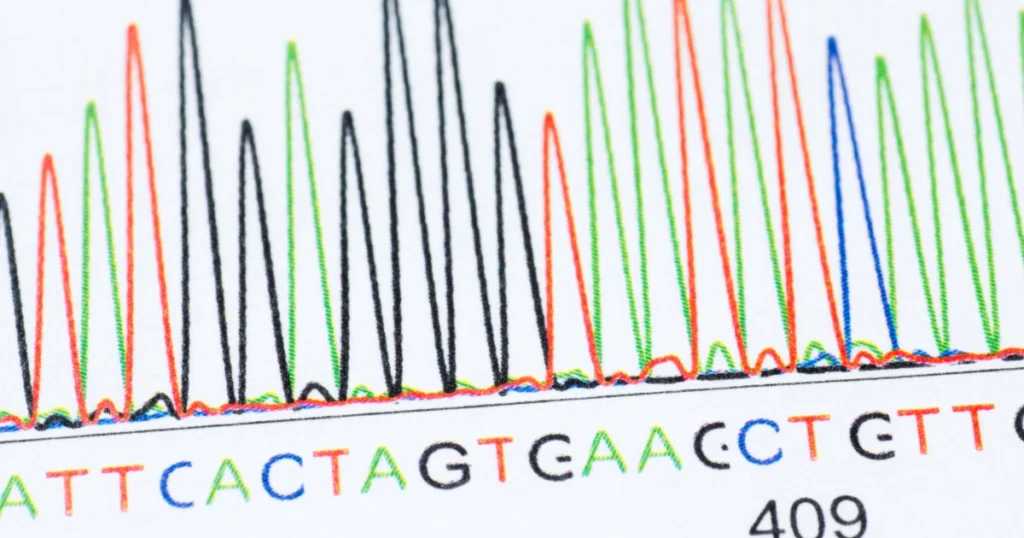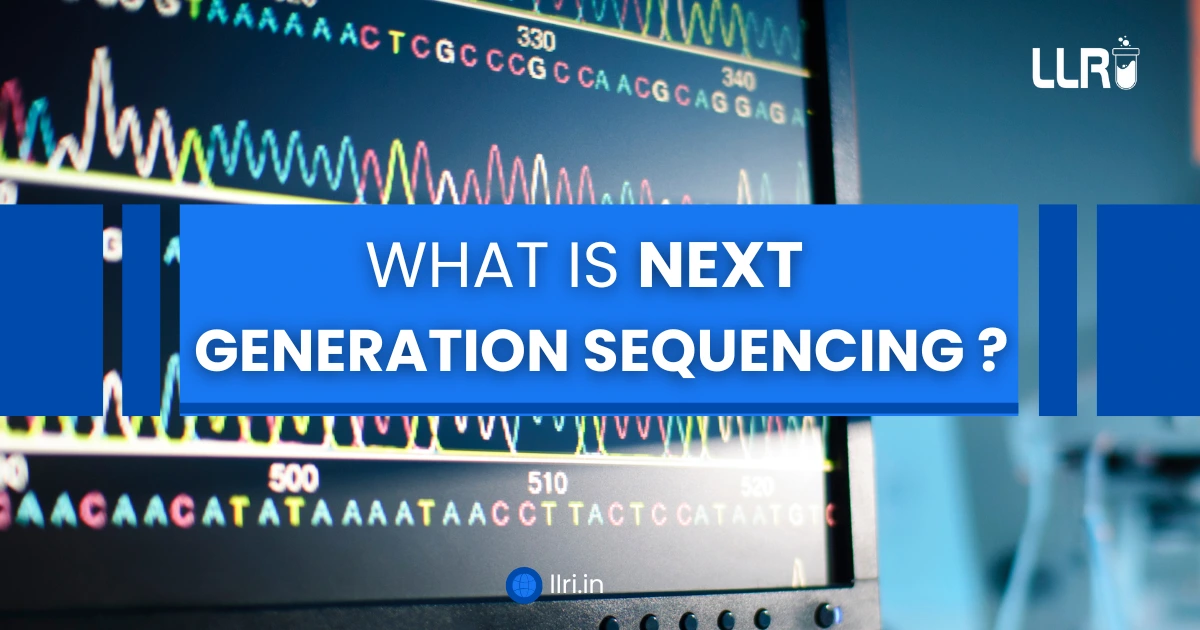What Is Next Generation Sequencing: Let’s imagine your DNA is a massive book. Reading it letter by letter would take years, right? That’s how it used to be. But then came Next Generation Sequencing (NGS), a method that lets us “read” entire bookshelves of DNA, all at once, in just a few hours.
So, what is next generation sequencing? It’s like a set of advanced lab technologies that help us decode DNA or RNA much faster, much cheaper, and in much larger volumes than ever before.
And no, you don’t need to be a scientist to understand it. Stay with me, you’ll get it all in the next few minutes.
What Is Next Generation Sequencing?
In the simplest terms, Next Generation Sequencing refers to modern DNA sequencing technologies that allow scientists to sequence (read) DNA and RNA much faster and cheaper than older methods. It’s like moving from dial-up internet to 5G, super quick and super-efficient.
The phrase “what is next generation sequencing” refers to a group of technologies that can process millions of DNA sequences in parallel. Traditional sequencing like Sanger sequencing could only handle one strand at a time, but NGS does it all at once.
“Next-generation sequencing has revolutionised genomic research, making it possible to sequence entire genomes within days instead of years.” – Nature Biotechnology Journal

Why Should You Care About NGS?
Here’s the thing: whether you’re a student, a doctor, or someone curious about how genetic tests work, understanding NGS can give you a huge edge.
NGS is the backbone of:
- Genetic disease testing
- Cancer research
- Personalised medicine
- Ancestry kits
- Virus tracking (remember COVID-19?)
It’s used in labs across India and the world to understand, prevent, and treat diseases by reading our genetic code. Next Generation Sequencing has become an essential tool in clinical diagnosis and personalised therapy.
Read More: What Should I Do After BSc? Explore Best Courses & Careers
But How Does It Actually Work?
The science behind next generation sequencing methods is complex. But here’s a real-world analogy:
Imagine you’re trying to copy 100 books word for word. Doing it manually will take years. But what if you had 1000 people working at once, each copying a page? That’s how NGS works. It breaks DNA into tiny pieces and reads them all at the same time.
The Main Steps of NGS:
- Sample Collection – From blood, saliva, or tissue.
- DNA Extraction – Get the DNA out of the cells.
- Fragmentation – Break DNA into smaller readable chunks.
- Library Prep – Add special tags so the machines know what to read.
- Sequencing – A machine reads all the fragments, base by base.
- Data Analysis – Software stitches everything back together and interprets it.
That’s the next generation sequencing principle, speed through parallel processing.
What Makes It Different from Sanger Sequencing?
Ah yes, the classic question: What’s the difference between next generation sequencing and Sanger sequencing?
Here’s the short version for difference between NGS and sanger sequencing:
| Feature | Sanger Sequencing | Next Generation Sequencing |
| Time | Slower, one sequence at a time | Faster, millions at once |
| Cost | Costly for large data | Affordable for big projects |
| Scale | Ideal for small samples | Perfect for whole genomes |
| Usage | Still used for single-gene tests | Used for complex, high-throughput testing |
So when you hear people asking about the difference between NGS and Sanger sequencing, just remember: Sanger is like using a typewriter, while NGS is like using a supercomputer.
Types of Next Generation Sequencing
There’s no one-type-fits-all approach when it comes to next generation sequencing techniques. Depending on the purpose, scientists choose from different types of NGS:
1. Whole Genome Sequencing (WGS)
Everything – from start to end – is sequenced.
2. Whole Exome Sequencing (WES)
Only the protein-coding regions (exons) are sequenced. That’s just 1% of the genome, but with 85% of known disease-causing mutations.
3. RNA Sequencing (RNA-Seq)
Used to study gene expression. It tells us which genes are active and how much.
4. Targeted Sequencing
Focuses on specific genes or regions, often used in cancer gene panels.
5. Single-cell Sequencing
Zooms in on individual cells, especially useful in tumour and brain studies.
Each of these types of next generation sequencing is like choosing different camera lenses, some give you the big picture, while others zoom in on the details.
Next Generation Sequencing Applications
Let’s make this super practical. Where is NGS used in real life?
1. Disease Diagnosis
Doctors use NGS to identify mutations in genes that cause inherited disorders or cancers. For example, a child with unexplained developmental delay might undergo WES to detect rare mutations.
2. Cancer Treatment
Many hospitals in India now use NGS panels to guide cancer treatment. It helps find mutations like EGFR, BRCA, or KRAS and personalise the therapy.
3. Infectious Disease Tracking
NGS helped sequence different COVID-19 strains. It’s also being used for TB and flu viruses.
4. Prenatal Testing
Expecting parents can opt for NGS-based non-invasive prenatal testing (NIPT) to check for chromosomal disorders like Down syndrome.
5. Research and Agriculture
NGS plays a huge role in improving crop genetics, studying soil microbes, and developing climate-resilient plants.
These are just a few next generation sequencing applications, but the list keeps growing.

What Are the Benefits of Next Generation Sequencing?
There are plenty of reasons why researchers and doctors prefer NGS. Here are the top benefits of next generation sequencing:
- Speed – Results in days, not months.
- Volume – Can read entire genomes in a single go.
- Cost-effective – Especially when sequencing lots of data.
- Accuracy – Identifies even tiny mutations with high precision.
- Versatility – Works for DNA, RNA, single cells, and more.
That’s why most modern labs have already moved to NGS. It’s not just faster—it’s more powerful.
On A Final Note…
So now you know the answer to what is next generation sequencing, it’s not just a fancy lab term. It’s a game-changing tool that’s helping us unlock the secrets of our genes at lightning speed.
Whether you’re trying to understand cancer, solve rare diseases, or grow better crops, next generation sequencing methods are helping us get there faster.
From medical diagnostics to biotechnology research, the difference between next generation sequencing and Sanger sequencing is night and day. And the benefits of next generation sequencing? Speed, accuracy, affordability, and insight.
FAQs
Q1: Can NGS replace all other genetic tests?
Not yet. While it’s more powerful, traditional tests like PCR or Sanger are still better for quick, targeted checks.
Q2: Is NGS available in India?
Absolutely. Labs in cities like Delhi, Mumbai, Bangalore, and Hyderabad now offer a wide range of NGS-based tests.
Q3: What’s the cost of an NGS test in India?
Depending on the test, it can range from ₹5,000 to over ₹50,000. Targeted panels are cheaper, while full genome sequencing costs more.
Q4: How long do NGS results take?
Anywhere between 7 to 21 days, depending on the lab and test type.
Q5: Is it safe?
Yes, the process itself is safe and non-invasive. Blood or saliva is usually enough.

